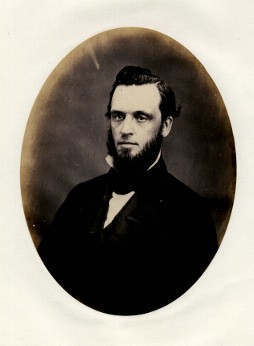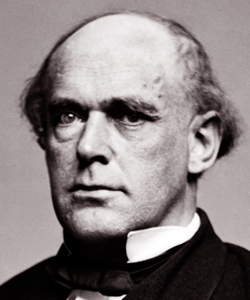Kidnapped into Slavery: Northern States’ Rights, Part 1
Thursday, December 19th, 2013by Ron Gorman, Oberlin Heritage Center volunteer docent
The movie 12 Years a Slave, now showing in northeast Ohio, graphically depicts several deplorable aspects of American slavery, including the fact that freeborn African Americans could be kidnapped and carried into a life of bondage. The true-life story of Solomon Northup, portrayed in the movie, was the result of an illegal kidnapping in Washington, D.C. But to make the story even sadder, in 1850, just nine years after Northup’s illegal abduction, the laws of the United States were modified, not to make it harder for such atrocities to occur, but in such a way as to make it easier – to in fact make such abductions possible with the full sanction of U.S. law and with the support of federal law officers and American citizens deputized to assist them, whether willingly or not. This blog will discuss how such a law could come to be, and how some northern legislators, like Oberlin’s James Monroe, eventually fought back, to defend the rights of their states to protect their citizens from the tragic fate of Solomon Northup.
James Monroe (courtesy Oberlin College Archives)
The law I’m alluding to is the infamous Fugitive Slave Law of 1850, passed at a time when this country was on the verge of splintering in two and disintegrating into civil war. The northern states (north of the Mason-Dixon line/Ohio River) had for the most part abolished slavery by then, to the point that only about 1% of their black population remained enslaved (in Delaware and New Jersey). In the southern states, however, slavery was flourishing, so that more than 93% of their black population was enslaved.[1] This led to tremendous tensions between the sections, as described by South Carolina’s “states’ rights” Senator, John C. Calhoun, in his last speech to Congress in early 1850:
There is a question of vital importance to the Southern section, in reference to which the views and feelings of the two sections are as opposite and hostile as they can possibly be. I refer to the relation between the two races in the Southern section, which constitutes a vital portion of her social organization. Every portion of the North entertains views and feelings more or less hostile to it… On the contrary, the Southern section regards the relation as one which can not be destroyed without subjecting the two races to the greatest calamity, and the section to poverty, desolation, and wretchedness; and accordingly they feel bound by every consideration of interest and safety to defend it.
Unless something decisive is done, I again ask, What is to stop this agitation before the great and final object at which it aims–the abolition of slavery in the States–is consummated? Is it, then, not certain that if something is not done to arrest it, the South will be forced to choose between abolition and secession? [2]
The “agitation” to which he refers includes several anti-slavery policies and practices of the northern states and their citizens, but one of the most irritating to southern slaveholders was what Calhoun called the failure of the North “to do her duty by causing the stipulations relative to fugitive slaves to be faithfully fulfilled.” In other words, the North was not cooperating, and even downright obstructing, the return of enslaved persons who had escaped from their owners in the South to seek freedom in the North. This, the slaveholders felt, was in violation of the fugitive slave clause of the U.S. Constitution:
No Person held to Service or Labour in one State, under the Laws thereof, escaping into another, shall, in Consequence of any Law or Regulation therein, be discharged from such Service or Labour, but shall be delivered up on Claim of the Party to whom such Service or Labour may be due. – Article IV, Section 2, Clause 3
Many Northerners felt differently, however – that the vagueness of this clause left them latitude to insure, at the minimum, that freeborn Americans like Solomon Northup would not be carried off into slavery. Without going into the long, complicated series of litigation and legislation that this clause precipitated in the decades prior to 1850, I’ll just suffice it to say that by 1850 the situation was as confused and turbulent as ever.
And so it was that a group of U.S. Congressmen crafted the “Compromise of 1850”, the latest in a long series of compromises designed to attempt to preserve a democratic Union by supporting and maintaining institutionalized slavery. One of the key pieces of this compromise was a new fugitive slave law, to enforce the fugitive slave clause of the Constitution. But this law was so tilted in favor of the slaveholders that the New York Evening Post called it “An Act for the Encouragement of Kidnapping.” [3]
The Fugitive Slave Law brought the Southern viewpoint, that a black person was assumed a slave until proven otherwise, into the northern states, where all people, white and black, were assumed free until proven otherwise. It required neither the alleged fugitive slave nor the alleged slaveowner to appear in person to testify. In fact, the alleged fugitive was prohibited from testifying in his/her defense altogether, while the alleged slaveowner need only file an affidavit claiming ownership and providing a physical description of the alleged fugitive. It established a set of federal Commissioners to “exercise and discharge” the provisions of the act. It also charged United States Marshals and Deputies with enforcement of the act. Where the Marshals had insufficient numbers to perform their duties, they were authorized to “summon and call to their aid the bystanders, or posse comitatus of the proper county.” And if any of the Marshals, Deputies, or bystanders refused or failed in their duties, they were subject to stiff penalties themselves, as anyone assisting an alleged fugitive would be as well. The act also provided for monetary remuneration of the Commissioners for each case they heard, to be doubled if they decided in favor of the alleged slaveowner.[4]
No wonder the Oberlin Evangelist lamented, “Everything is yielded to the slave power which can be asked… O this horrible legislation for iniquity, and against freedom and righteousness!” And yet it passed both houses of the United States Congress, and was signed into law in September, 1850 by President Millard Fillmore. It was overwhelmingly opposed in Ohio, where abolitionist Senator Salmon P. Chase voted against it (his colleague, Senator Ewing not voting), and 14 Representatives voted against it while only 3 voted in its favor. But it had virtually unanimous Southern support, and enough northern Congressmen either voted for it or abstained from voting altogether, to dress this “hideous deformity”, as Oberlin’s John Mercer Langston called it, “in the garb of law.”[5]
Even the Cleveland Plain Dealer, noted for its vehement anti-abolitionist opinions, complained that the law was not “confined to the slave States,” but was enforced “wholly in the free States… by free men. The service it requires is not the kind we owe to either God, man, or the devil.” [6] Lewis Tappan, the abolitionist New York merchant and key benefactor of Oberlin College, minced no words:
It constitutes at the North, in our neighborhoods, and by our firesides, the most anomalous, overshadowing, insulting, and despotic police that perverted mind can contrive, or guilty power sustain—a police which guilty power cannot sustain, until honor, and purity, and freedom have fled from among us, and we have consented to be the most drivelling, and base, and worthless slaves that ever crawled at the foot of tyranny. [7]
But it was now the law of the land and President Fillmore ominously pronounced the Compromise of 1850 a “final settlement.” The nation now watched and waited to see if the “finality” would hold. But as it turns out, it didn’t even take four months for a freeborn black man to be “returned” to slavery under this law. On December 21, 1850, a United States Commissioner in Philadelphia ordered that Adam Gibson be sent to his alleged owner in Maryland, based on the testimony of a witness who was currently under indictment for kidnapping. Fortunately for Gibson, his alleged owner was honest enough to admit the error and return him to Pennsylvania, otherwise Gibson would have suffered the same horrible fate as Solomon Northup. One can only wonder how many Adam Gibsons weren’t so lucky. [8]
Over the next few years scores of blacks were arrested under this law, with the vast majority being remanded to slavery. But other than a handful of rescues, Notherners were powerless to do anything about it. In 1853, Solomon Northup was finally released from his 12 year ordeal and published his narrative, further dismaying the northern public. Northern indignation grew with each rendition and reached a crescendo in 1854, when President Franklin Pierce sent hundreds of U.S. troops to Massachusetts to return Anthony Burns to slavery, marching him through the Boston streets as crowds watched helplessly and church bells tolled in lament. [9]
Still, only one northern state, Vermont, had been able to pass legislation to dilute the effects of the Fugitive Slave Law, but it was too far away from ‘ground zero’ to make an impact. But another momentous event occurred at the same time as the Burns debacle that would change everything. The United States Congress passed the Kansas-Nebraska Act, allowing slavery into Kansas and Nebraska, which at that time were United States territories. Many Northerners felt this was a flagrant violation of the Missouri Compromise of 1820, which had prohibited slavery in the territories that far north. Having simmered with indignation while they upheld the Compromise of 1850, Northerners now boiled over into action. The anti-slavery Republican Party was formed, and state legislatures began to pass “personal liberty laws” to counteract the Fugitive Slave Law. [10]
Ohio had its first opportunity to test the waters of this new political climate in the election of 1855, and the result was a stunning victory for the infant Republican Party. Republicans took control of both houses of the Ohio General Assembly, and Republican abolitionist Salmon P. Chase was elected Governor. One of the new freshmen Republican members of the Ohio House of Representatives was another abolitionist, Oberlin College Professor James Monroe.
Salmon P. Chase
When the Republicans took office in January, 1856, Monroe, despite being a political rookie, immediately began feeling out his Republican colleagues on the idea of passing personal liberty laws in Ohio. As he wrote in his personal notes, “If Ohio would be a free state with free citizens & maintain the great safeguards of liberty, she must make a stand.” He quickly discerned, however, that “about one half of the Republicans were very conservative” and “had nothing that could be called anti-slavery principle as that term was understood in Oberlin.” [11]
Then another momentous event occurred, this time in southern Ohio, that changed everything once again. Just three weeks after the Republicans took office, news broke of the tragic Margaret Garner affair (see my Lucy Stone and the Margaret Garner tragedy blog for details). Ohioans were horrified at the story of the freedom seeker who had killed one of her children in Cincinnati rather than letting slavecatchers take her. Years later, Rutherford B. Hayes, the 19th President, who had been an abolitionist lawyer in Cincinnati at the time, told Monroe of the reaction in Cincinnati:
[Hayes] lived in a street of Southern sympathizers; but, as he expressed it, the whole street was converted by the tragedy of Margaret Garner. The next day after it occurred, a leader among his pro-slavery neighbors called at his house, and as he met Mr. Hayes, exclaimed with great fervor, “Mr. Hayes, hereafter I am with you. From this time forward, I will not only be a Black Republican, but I will be a damned abolitionist.” [12]
Governor Chase and other state and local anti-slavery officials had tried every trick in the book to get Garner and the rest of her family out of federal custody, but they could not get past the Fugitive Slave Law, and the whole family was eventually returned to slavery. The Governor was incensed at the impotence imposed upon him, and he vented his frustration to Monroe:
… there was a knock at my door, and Governor Chase entered. He was laboring under great excitement of some kind, and appeared to be angry. He broke out abruptly, “What are you Republicans doing in the House, and what are you doing, Monroe, when a mother who is a free woman is compelled to kill her children on the soil of Ohio to save them from slavery, and that because there is no efficient law for her protection?… You ought to introduce a bill into the House in the morning, have it carried through both Houses under a suspension of the rules, and have it become a law before you adjourn to-morrow.” [13]
Though it didn’t happen quite that fast, Monroe, with Chase’s support, in the wake of the outrage over the Garner case, wrote and passed a law that would arguably become one of the most radical personal liberty laws in the country. The law went into effect on April 5, 1856. It was a law that Monroe would say years later “had not much growl or bark in it, but it had plenty of teeth.” Its critics would call it “insane and aggressive legislation” (and that’s when they were being nice.) I’ll discuss this very intriguing law in detail in my next blog post. [14]
It would be a full year after passage of Monroe’s law before the Ohio legislature would pass any further personal liberty laws, and when they did they would be among the most conservative of such laws. In the Spring of 1857, they passed “An act to prohibit the confinement of fugitives from slavery in the jails of Ohio”, and “An act to prevent slaveholding and kidnapping in Ohio”, and “An act to prevent kidnapping”. The latter law would turn out to be the most noteworthy of the three. Here’s an excerpt:
… no person or persons shall kidnap or forcibly or fraudulently carry off or decoy out of this state any black or mulatto person or persons within this state, claimed as fugitives from service or labor, or shall attempt to [do so], without first taking such black or mulatto person or persons before the court, judge or commissioner of the proper circuit, district or county…
… any person or persons offending against the provisions of this act shall be… confined in the penitentiary at hard labor for any space of time not less than three years nor more than eight years… [15]
Three to eight years hard labor in the notorious Ohio State Penitentiary. That sounds pretty severe in our day and age. But it pales by comparison to Solomon Northup’s twelve years of brutality and “unrequited toil”, or the life sentences that hundreds of victims of the Fugitive Slave Law endured. Nevertheless, the new laws made an impact, as we shall soon see. Stay tuned.
SOURCES CONSULTED:
James Monroe, Oberlin Thursday lectures, addresses and essays
Thomas D. Morris, Free Men All: The Personal Liberty Laws of the North 1780-1861
William Cox Cochran, The Western Reserve and the Fugitive Slave Law
Lewis Tappan, The Fugitive Slave Bill: Its History and Unconstitutionality
John C. Calhoun, “The Clay Compromise Measures”, National Center for Public Policy Research
Samuel May, The Fugitive Slave Law and its Victims
“Doings of Congress”, Oberlin Evangelist, September 25, 1850
Carol Wilson, Freedom at Risk: The Kidnapping of Free Blacks in America, 1780-1865
David M. Potter, The Impending Crisis: 1848-1861
James M. McPherson, Battle Cry of Freedom
“Fugitive Slave Act, 1850”, National Center for Public Policy Research
Joseph Rockwell Swan, The Revised Statutes of the State of Ohio, of a General Nature, in Force August 1, 1860
“Historical Census Browser, 1850”, University of Virgina Library
“Amendment of the Habeas Corpus Act”, Oberlin College Archives, RG30/22, “James Monroe”, Box 19
Clement L. Vallandigham, SPEECHES, ARGUMENTS, ADDRESSES, AND LETTERS OF CLEMENT L. VALLANDIGHAM
President Millard Fillmore, “First Annual Message, December 2, 1850”, The Miller Center
Philip S. Foner, “History of Black Americans From the Compromise of 1850 to the End of the Civil War”
Solomon Northup, Twelve Years a Slave
FOOTNOTES:
[1] “Historical Census Browser”
[2] Calhoun
[3] May, p. 3
[4] “Fugitive Slave Act”
[5] “Doings of Congress”, p. 6; Tappan, pp. 12-16; Foner
[6] Cochran, pp. 103-104
[7] Tappan, p. 29
[8] Fillmore; May, p. 12; Wilson, pp. 52-53
[9] Potter, p. 138; McPherson, pp. 119-120
[10] Morris, pp. 159, 168
[11] “Amendment”, p.2; Monroe, p. 111
[12] Monroe, p. 116
[13] ibid., p. 117
[14] ibid., p. 120, Vallandigham, p. 154
[15] Swan, p. 418








